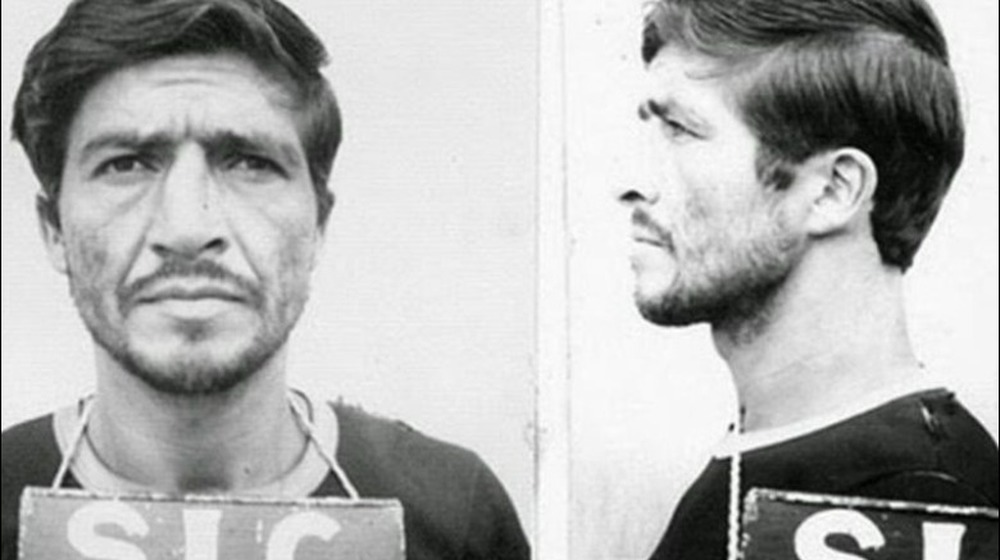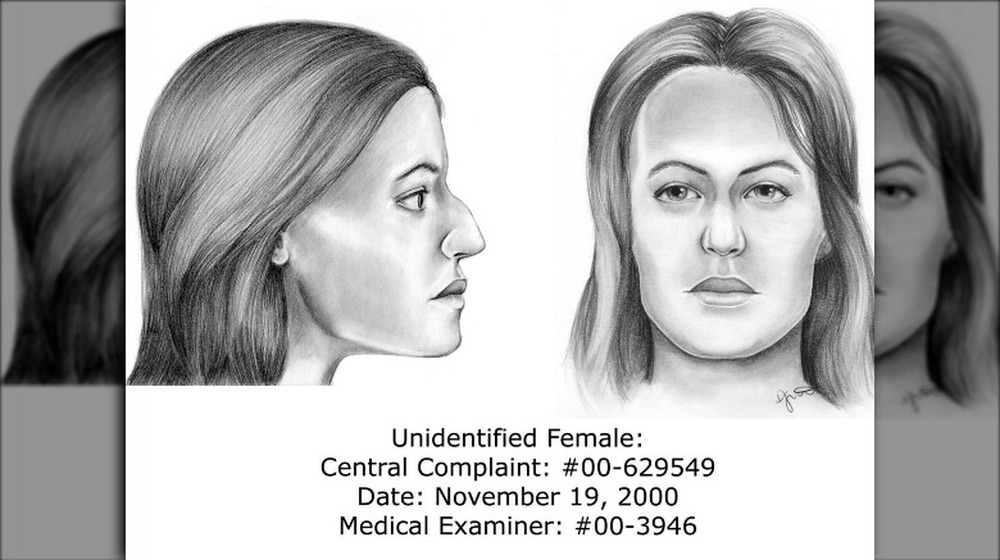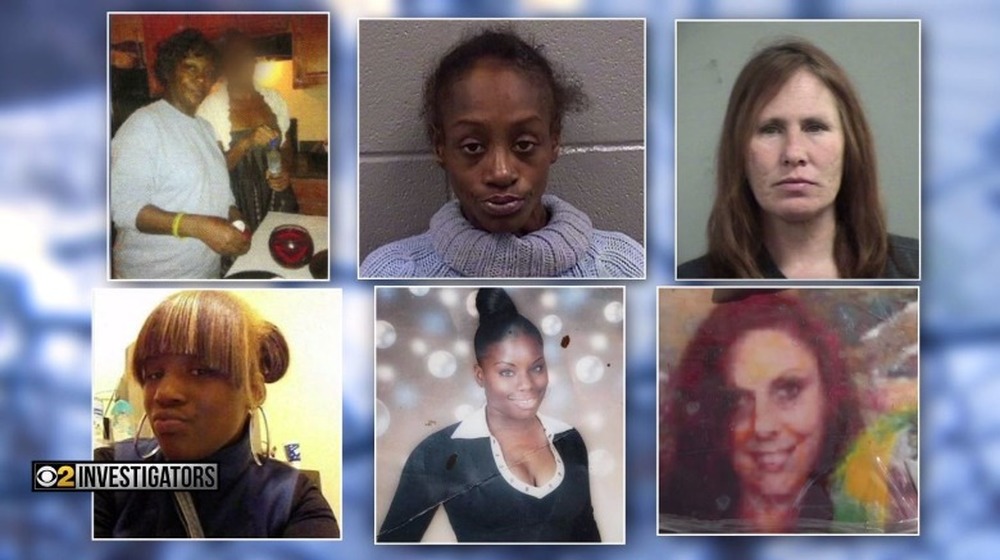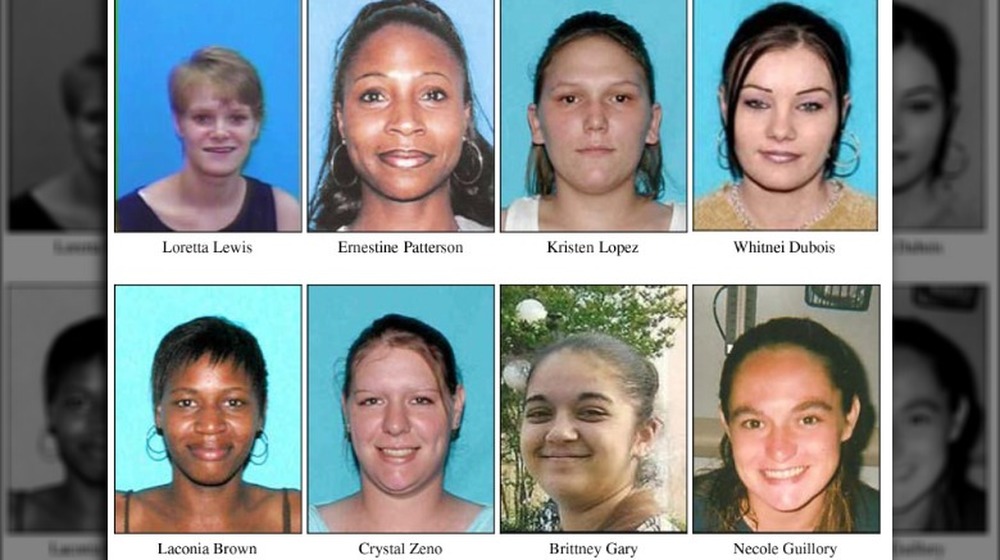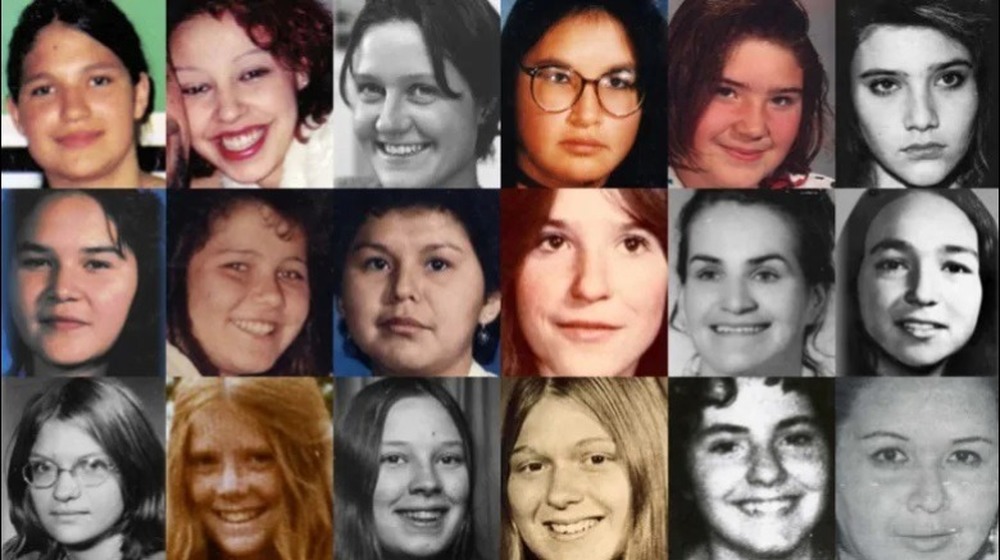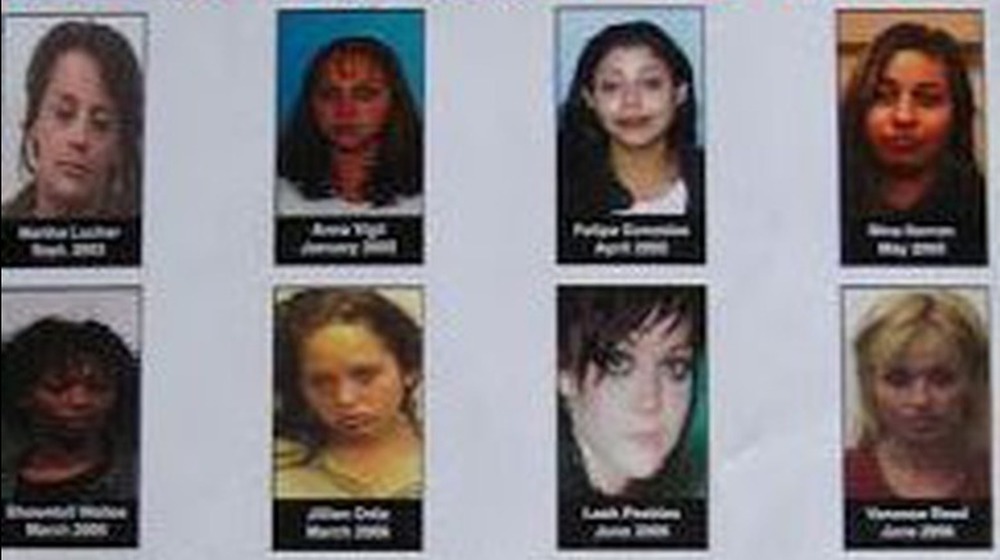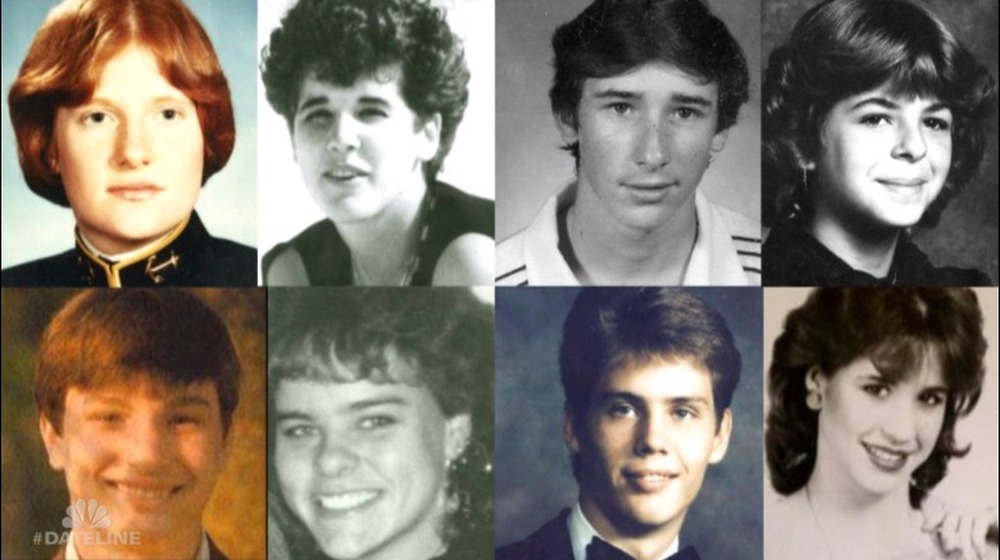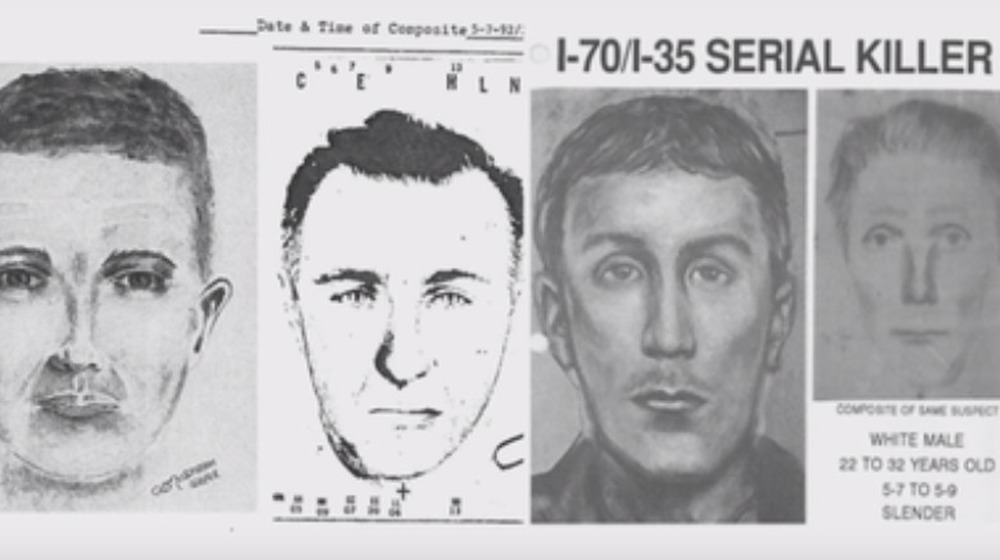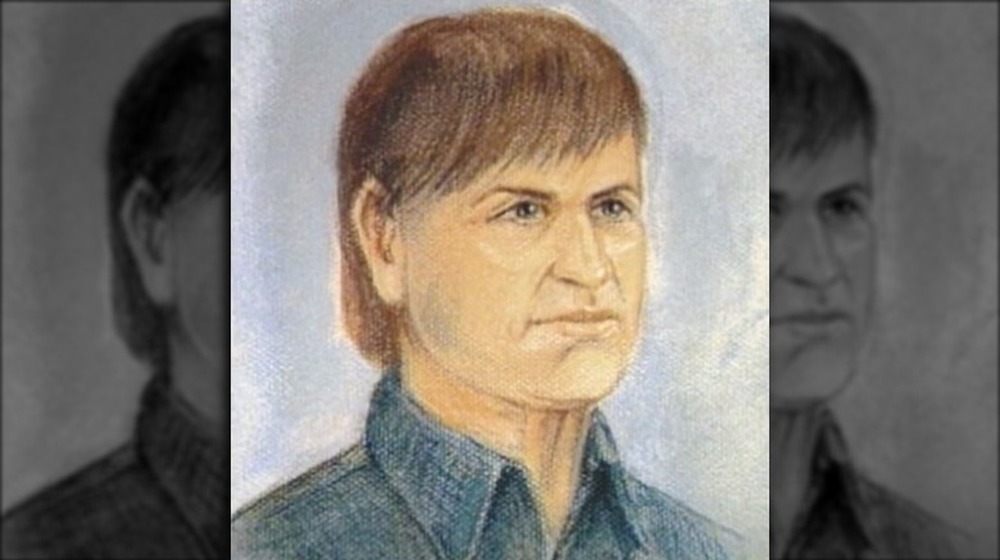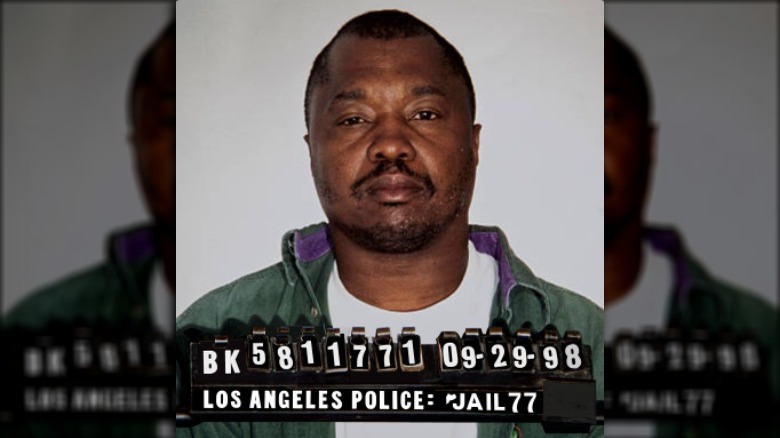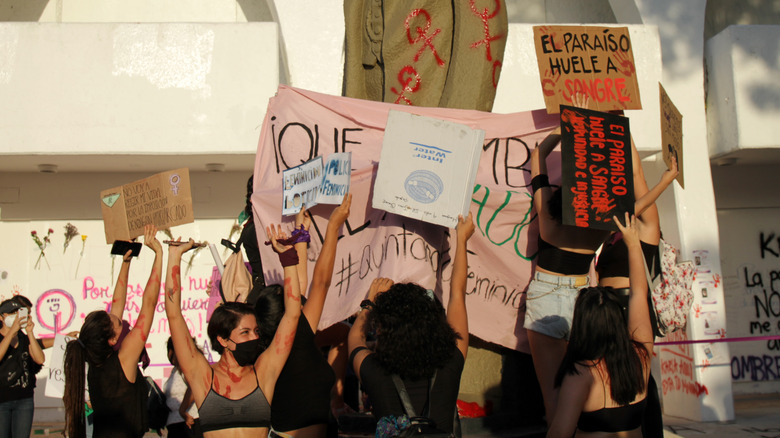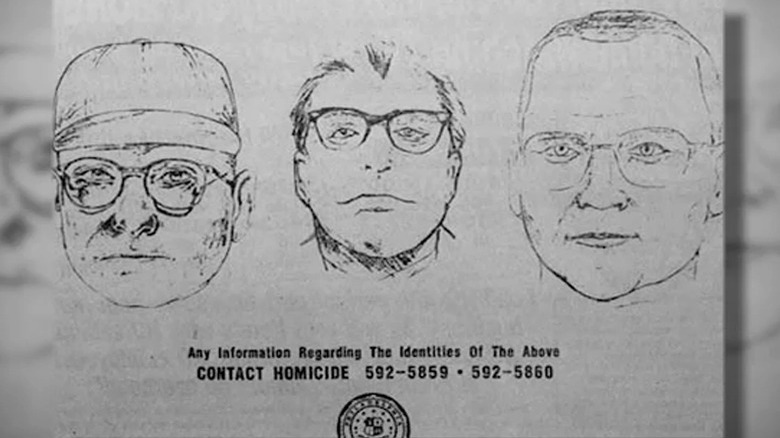The Most Dangerous Active Serial Killers In 2021
Watch almost any crime drama on TV today, and it might seem like cops always get the bad guy within the hour. But we all know that's not true, and the scale on which it isn't true is a little mind-blowing.
According to the US Department of Justice, the closure rate on 2017 murder cases was only at 62 percent. The rest went unsolved, and that's all contributing to an ever-growing number of cold cases. They estimate that across the US, there's somewhere around 250,000 unsolved murder cases that are still open. That's going up all the time, and law enforcement estimates there's going to be about another 6,000 added to that number every year. It's a huge deal: according to Tom McAndrew, a former Pennsylvania State Trooper, "... all unsolved homicides potentially have offenders who have never been apprehended. History and research show that a violent offender will likely repeat."
Advances in DNA technology mean that there is a chance that some of these offenders will be caught. Take the Golden State Killer, a serial killer linked to crimes that spanned decades. He started killing in 1976, and was only identified and arrested in 2018. The good news is that there is hope we'll see justice for the victims and their families, so let's talk about some of the most prolific serial killers still out there.
Pedro Alonso Lopez: Monster of the Andes
The widely accepted definition of a serial killer is (via Crime Museum): "a person who murders three or more people in a period of over a month, with "cooling down" time between murders." Now, let's consider the case of Pedro Lopez, a Columbian serial killer who has hunted his way across South America and is still at large. He's gone way, way, way past that.
According to Rolling Stone, Lopez's predilection for assault and murder started when he was young. Born in 1948 (via Biography), he was eventually arrested in Ecuador in 1980. It was there that he confessed to 110 murders in Ecuador alone, and later added 240 more victims across several other countries. He preferred children between seven and 12-years-old, and was a suspect in a further 300 killings. Prosecuting him would be difficult, and it turns out that it's possible for the story to get even more disturbing.
Lopez served 14 years of a 16-year sentence in Ecuador when he was released early for good behavior. Then, he was immediately sent back to his native Colombia and put on trial for the murders committed there. The end of the trial saw him committed to a psychiatric institution, and he remained there for four years — until 1998. That's when he was released on good behavior and $50 bail. He hasn't been seen since, but he has been connected to still more killings.
The Long Island Serial Killer remains unidentified
It took some time for the full scale of the case to unfold, and when it did, it became what 48 Hours calls "the biggest unsolved murder case in NY history."
It started with a 23-minute 911 call, made by Shannan Gilbert. Gilbert — an escort — had just been dropped off at a client's home when, three hours later, she fled that home, ran to a neighbor, asked for help, then disappeared. That was in May 2010, and it wasn't until December 11 of the same year that the manhunt for Gilbert started turning up bodies along Long Island's Gilgo Beach. Those bodies included Maureen Brainard-Barnes, who had been missing for three years, and Megan Waterman, who left behind a three-year-old daughter. More remains were discovered in the following months, bringing the total to 10.
Fast forward more than a decade, and not only is the killer still out there, but five of the women found along that lonely stretch of beach remain unidentified (including the woman in the attached police sketch). According to ABC News, the case is still very active and recently, new evidence — including a photo of a belt bearing the initials WH or HM — were released to the public. In 2020, Netflix released Lost Girls based on the killings, but no new information came to light in the aftermath of the release, and the killer remains at large.
A serial killer is preying on the women of Chicago
In January 2021, the Chicago Sun-Times ran a profile piece on Gwendolyn Williams. She loved to dance, they said, and was a fierce protector of her younger siblings. She taught them how to stay on the straight and narrow, encouraged them to follow their dreams, and to stay in church. She loved to cook, and her family called her their "guardian angel."
Her body was discovered on June 12, 2002, bearing defensive wounds and signs — like skin under her nails — that showed she'd tried to fight off whoever had killed her. And it wasn't just Williams: police believe she is one of 51 Chicago women who have been the victim of a serial killer operating in the city since 2001.
According to The Chicago Tribune, the victim count may be 55, 75, or higher. By the time law enforcement put together a task force to treat the murders as connected, at least four more potentially connected victims had been discovered. In late 2020, investigators had turned up a slew of non-matching DNA samples in the cases, but stressed (via Northwestern Medill) that the fact there was no DNA in the overwhelming majority of murders pointed toward the likelihood that this was one very careful, very intelligent killer. Why wasn't the trend of missing DNA evidence discovered sooner? Because, the Illinois State Forensic Labs are, in some cases, 30 years behind in analyzing evidence from certain cases.
The Killing Fields murders
According to a 1999 issue of Texas Monthly, the Killing Fields — the name given to a strip of abandoned oil fields near Interstate 45 — have long been known as a favorite dump site for killers. In 1984, news went national with the discovery of four naked, carefully posed, female murder victims. At the time, law enforcement had a suspect: Robert Abel, a NASA engineer who worked on the original Apollo missions. Abel was around 60-years-old when the murders — and more disappearances — happened, and the same law enforcement officials who considered him a suspect were also forced to admit that they had absolutely no evidence that he had anything to do with the killings.
Abel insisted that he was innocent, but it's undeniable that some killer was at work along this lonely stretch of highway. The 30+ young women who have been killed or gone missing over the course of decades are sometimes collectively referred to as the I-45 killings, and according to The Washington Post, a few perpetrators have been caught, but most cases — including the killing of those four women — are still open.
Two of those four victims discovered in the mid-80s were only identified in 2019, thanks to advances in genetic analysis. Tim Miller, the father of victim Laura Miller, has since turned the Killing Fields into a memorial for all missing loved ones, and hopes that someday, the killer will be caught.
The Jeff Davis 8
The Jeff Davis 8 is the name given to eight women who were killed in regular intervals from 2005 to 2009. According to The Washington Post, they were all between 17 and 30-years-old, they were all associated in some way with area's drug and sex work trade, and they were all from Jennings, Louisiana. By fall of 2009, Biography says that law enforcement went on the public record to state that the murders were undoubtedly the work of one serial killer, and that they were offering a reward leading to his capture.
But not everyone was convinced, including an investigative journalist named Ethan Brown. He would later write Murder in the Bayou based on his findings, and the gist of the accusations is this: Brown found that all eight victims had some sort of relationship — some sexual, some as informants — with local law enforcement. That — and insight from their shared pimp, Frankie Richard — led him to believe that the women died in some sort of massive cover-up. (According to Observer, the idea that law enforcement was involved in the deaths of the Jeff Davis 8 was the real-life story that inspired HBO's True Detective.)
Whether the killer — or killers — were from law enforcement or a serial offender working alone, the murderer remains at large and the cases are unsolved.
The Highway of Tears killer
There's a stretch of Canada's Yellowhead Highway 16 between Prince Rupert and Prince George where the scenery includes billboards warning women not to hitchhike. They're there because there have been so many bodies recovered along this stretch of road that it's now popularly called the Highway of Tears.
The Canadian Encyclopedia says it's unknown just how many people have been killed along this stretch of highway, and even though the Royal Canadian Mounted Police officially say the number is 18 (as of 2019). However, Human Rights Watch — along with Indigenous groups in the area — say the actual number is closer to 40, as many of those who have disappeared — or been killed — belong to oft-overlooked Indigenous populations. Unsolved murders along Highway 18 go all the way back to 1969, and in 2016, RCMP Staff Sgt. Wayne Clary had some somber words for CBC. "I've been honest with our [victims'] families and I say perhaps they'll never be solved," he told the news agency. A task force called E-PANA was assembled in 2005 to investigate disappearances, but since, the number of people assigned to the task force has dropped from 70 to just eight.
Clary says that in many of the still-open cases, the years have not been kind. Evidence is lost, witnesses have died, and sometimes, victims' bodies go undiscovered in the wilderness. Clary says: "We care, and we're trying, and we'll keep following up on the tips and interviews that come in."
West Mesa Murders
It started with a list of names, compiled by an Albuquerque detective starting in 2005. The names added up quickly, but it wasn't until 2009 that law enforcement uncovered their remains.
According to the Albuquerque Journal, the first human bone was found on February 2. Vice adds that it was weeks before all the bodies were uncovered and another year before the women were identified, and 10 of the 11 women were on Detective Ida Lopez's list of missing women with ties to the city's high-crime, Central Avenue area (pictured). (Seven more women on the list are still unaccounted for, leading experts to believe there are other burial sites.) At the time, it was reported in the national media as the "crime of the century," but fast forward through the years, and there's still been no real suspects named, much less arrested.
George Walker is a private investigator who had been working the case, and he's stressed that there's a very real possibility that the killer was never caught because he's no longer in the area. Walker says: "There's a possibility the killer has come and gone. Serial killers move; that's why they don't get caught. If he didn't get caught, I'm sure there are more victims somewhere. He could possibly be on the loose in New Mexico, or another state."
The Rainbow Maniac
The first victim of the serial killer dubbed the Rainbow Maniac was Jose Cicero Henrique. He was killed on July 4, 2007, then dumped in Sao Paulo's Paturis Park — and he wasn't the last. According to The Guardian, 13 men in total were killed and dumped in the park against the backdrop of Brazil's gay pride march, leading police chief Paulo Fernando Fortunato to explain, "He doesn't like homosexuals, he hates them."
It wasn't until six months after Henrique's body was discovered that police even announced they knew they were dealing with a serial killer they'd linked not only to the Paturis park killings, but to three more murders in a nearby city. The announcement came alongside the arrest of a retired police officer, says NBC News, but in spite of a witness that identified the man as having been the shooter in at least one of the murders, he was ultimately acquitted (via Agora).
No other arrests were made, and violence against members of Brazil's gay community continued to rise. The Guardian reported in 2018 that crime had continued to rise after a staggering 30 percent increase in violent crimes from 2016 to 2017, and Reuters reported that threats made against recently elected transgender councilwomen were considered as heralding another wave of violence against the community.
The Skid Row Stabber
For a long time, it seemed that LA's homeless community could rest at least a little bit easier: the Skid Row Stabber had been caught. The months of October and November, 1978, had been a terrifying time, when 10 homeless men were brutally murdered in the streets.
According to the LA Times, police honed in on Bobby Joe Maxwell after discovering two pieces of evidence: his handprint on a bench near one crime scene, and the fact that he owned a knife that could have made the wounds in some of the stabbings. Add in the testimony of a man named Sidney Storch, and it was an open and shut case.
Only, it definitely shouldn't have been. Years later, new information came to light: Storch would use details from public news reports to put together false confessions he then claimed to have heard from fellow inmates, like Maxwell. That was in 1998, and shockingly, it wasn't until 2010 that Maxwell's conviction as the Skid Row Stabber would be overturned, and it still wasn't over. According to AP, Maxwell was still fighting the charges in 2018, and they were finally dismissed in August. By then, Maxwell was hospitalized and comatose following a severe heart attack. He died in May of the following year, and the real Skid Row Stabber was never caught.
The Colonial Parkway Murders
Three years, eight bodies, and a 23-mile-long section of Virginia Highway: that forms the backbone of the so-called Colonial Parkway Murders.
At a glance, Oxygen says there's a lot of evidence that seems to suggest the eight murders were the work of the same person. Victims were killed between October 1986 and September 1989, they were all young couples killed at the same time, in the same area, and each set of victims seemed to have been reaching for identification or registration information when they were taken from their cars. That last detail led to the belief that the killer was (or was posing as) law enforcement.
But given the different ways in which the victims were killed, some investigators were hesitant to call it the work of a serial killer. Revisiting the case in 2021, Bill Thomas — producer of a four-part Oxygen series on the murders and brother of one of the victims — says (via Fox News) that with renewed interest in the case and advances in forensic technology, he hopes that there's still a chance to bring his sister's killer to justice.
The I-70 Killer
The first victim was killed on April 8, 1992, and the last (known) victim died on May 7 of the same year. In just a few short weeks, six people — all brunette, and all retail workers along a stretch of Missouri highway — were killed in the same way. Each one was shot with a .22 caliber rifle, there was no sign of sexual assault, and so little was taken from each store that robbery was written off as a motive. According to Vox, the killings seemed to stop as abruptly as they started, and the serial killer was never identified.
According to InsideHook, eye-witnesses described the killer as "a guy who had been sleeping in his clothes," who talked to himself as he hung out around the stores where the victims would later be found. Some witnesses later said they'd seen him hitchhiking away from the scene.
But the Courier & Press says that's not the end of the story. Donald Waterhouse was originally on the suspect list — he'd reportedly killed his mother and stepfather with the same caliber rifle not long before the I-70 killer struck — but in 1993 and 1994, Texas experienced a similar set of murders... while Waterhouse was behind bars. Three more store clerks were shot in their workplaces (and this time, one survived). The two sets of killings were never officially linked by law enforcement, but to some, the coincidence could seem like just too much to be just a coincidence.
The Route 29 Stalker
According to NBC News 12, the Route 29 Stalker had a pattern: he'd pull up alongside or behind women who were driving, and if they stopped, he'd try to convince them there was something wrong with their vehicle. He'd offer to give them a ride, and that's how he killed Alicia Showalter Reynolds.
Reynolds was killed on March 2, 1996 — and that's also when appearances of the Route 29 stalker stopped. She was missing for more than 2 months before her body was discovered, and she's not the only person to meet a grisly fate along Virginia's Route 29. Investigators have found a string of cases where women disappear from the same stretch of road, including Morgan Harrington in 2009, Samantha Clarke in 2010, and Dashad Smith in 2012.
When Harrington's remains were discovered and identified, law enforcement also recovered DNA that was a match to a rape case from northern Virginia. Jesse Matthew Jr. was convicted in 2016 of Harrington's murder and is serving four consecutive life sentences.
It remains unclear whether or not the string of other disappearances are the work of a single killer, or if several predators are stalking this particular stretch of road through Virginia.
Are the Smiley Face Killers real?
If there's anything that's more terrifying than a serial killer stalking the streets, it's the possibility that one might be hiding in the shadows ... but, no one's sure.
That, says Rolling Stone, is the case with a series of suspicious deaths with eerie similarities — the victims are white, college-aged men, their deaths are ruled accidental and usually attributed to alcohol, and their bodies turn up in local rivers. Are the drownings really, truly accidental, or are they the work of a serial killer or killers?
The latter is the theory of former NYPD detective Anthony Duarte, retired Boston detective Kevin Gannon, and professor of criminal justice Lee Gilbertson. They believe the deaths are linked by the presence of smiley face graffiti, marking victims as having been targeted by a gang — likely, for their perceived, privileged status. Those that believe the serial killer theory also point to things like a similarity in decomposition rates and the presence of a drug called GHB, detected in many of the autopsies.
Shockingly, they've found some 335 cases considered suspicious enough to be linked with the potential Smiley Face Killers ... back in 2019. The FBI maintains there's not enough concrete evidence to link the deaths, and it remains unclear whether they're unfortunate accidents, or something more. Are people seeing patterns that aren't there? It's possible — former FBI agent Bryanna Fox explains that sometimes, it's easier to believe in a serial killer than in our individual vulnerability to tragedy.
The Butcher of Mons
Mons is a city in Belgium, and between January 1996 and January 1997, five women were brutally murdered, then dismembered. The killer became known as The Butcher of Mons, and then? He stopped.
No one has ever been convicted of the crimes, but that's not entirely the end of the story. According to The New York Times, let's jump a bit back in time — and across the ocean — to September 1990 and Brooklyn. That's when a garbage bag containing the pieces of a 61-year-old woman named Mary Beal was discovered. The investigation eventually led to a man named Smajo Dzurlic, who first knew Beal as the translator who worked on his divorce. Long story short, he was long gone by the time detectives got to his apartment.
Now, fast forward to 2006. Amid rumors that Dzurlic had been bouncing around Europe came the discovery of a similarly mutilated body that was dumped in an Albanian lake. Law enforcement started to connect the dots, and Dzurlic was arrested in Montenegro. In 2010, he was found guilty of Beal's murder.
But not of being the Butcher of Mons, in spite of law enforcement's best efforts. Belgian officials came up empty when they tried to prove he was in Mons during the rash of very similar killings. But in spite of widespread belief the murder victims were his, it's entirely possible they weren't — and the Butcher is still out there.
The hunt for the Belize Ripper
The entire country of Belize has a population of about 230,000 people, and for reference, that's about the same population as the city of Boise, Idaho. In 1999, Belize was faced with the realization that they were dealing with their very first serial killer, and he was hunting young girls.
According to the Los Angeles Times, the bodies of seven girls were recovered in the span of just one year — and there was a pattern. Victims were mostly from low-income, single-parent homes, and often forced into the shadier side of city life in order to make ends meet ... and put food in their school lunchboxes.
Suspects came and went, but other victims kept showing up. When suspect Michael Williams was in custody, for example, 9-year-old Erica Williams went missing. Other arrests were made as people demanded justice, but no one was ever tried and convicted of the killings.
Belize's News 5 called for an investigation into links between the murders and American serial killer Lonnie Franklin — otherwise known as the Grim Sleeper — for what they called a highly suspicious connection. Not only had Franklin married a woman from Belize, but witnesses saw him in Belize City around the time of the murders, and the "sleep period" that gave him his nickname coincided with the killings. Was he not sleeping at all? Or did Belize's child-killer go free?
Femicides in Ciudad Juarez
It's not clear just how many women have died in the city of Juarez since the 1990s, but NPR says that the numbers are in the hundreds. While there is undoubtedly more than one killer stalking the streets for victims, there's almost certainly a serial killer or two, as well. Basically? Authorities just don't know.
Protests kicked off again in 2020 after the murder of Isabel Cabanillas de la Torre, who was shot in the head as she rode her bicycle home one night. She had become one of many women killed simply because they're women, a crime so common it's been given the name of "femicide." According to The Seattle Times, the killings started in earnest in the mid-1990s, when reports of "bodies found en masse in the Chihuahuan desert" started to make international news. And it's only gotten worse, and between 2014 and 2019, the numbers of the dead increased by 137%.
Between 1993 and 2020, at least 1,700 women were killed simply because they were women. Sometimes, remains are found — often bearing signs of torture and abuse. Sometimes, they simply disappear. Most of the cases remain unsolved, and sometimes, families get horrible closure.
Ernestina Enriquez Fierro's 15-year-old daughter, Adriana, disappeared off the streets of Juarez in 2008. It wasn't until 2011 that Fierro saw a Facebook post that confirmed her daughter's remains were among those that had been discovered in 2009. She said, "I ask — is being a woman a crime?"
South Africa's elusive Sleepy Hollow Killer
The definition of a serial killer has changed over the years, and it's even been argued that the so-called "cooling off" period that many seem to go through isn't actually an integral part of the definition. Psychology Today says, however, that understanding the cooling-off period is crucial from a behavioral and psychological point of view ... and that brings us to the Sleepy Hollow Killer.
Starting in September 1997, there were a series of killings in South Africa's KwaZulu-Natal's Pietermaritzburg area (via i0L). News reports say that the so-called Sleepy Hollow Killer was responsible for the murder of at least 13 women, all of whom were strangled with their underwear. Investigations seemed to stall, and not all of the women were identified. Then, in 2007, the killings seemed to start again.
Authorities say that while the three women who were killed in 2007 were "burned beyond recognition," they also shared characteristics with the original 13 victims — they were found around the N3 highway, and the method of killing was the same. Experts shared, reports News 24, that it was entirely possible that the Sleepy Hollow Killer had returned, and a former investigator who spoke on the condition of anonymity said, "We knew he would not stop. A serial killer never stops killing."
Philadelphia's unidentified Frankford Slasher
Having a serial killer active in your own backyard is a terrifying prospect, and between 1985 and 1990, that's exactly what was going on in Philadelphia. The so-called Frankford Slasher killed at least eight women in five years, and according to NBC Philadelphia, there was a pattern. The women were all white, they were all locals who were known customers of the bars within a three-block stretch of Franklin Avenue, they were all assaulted, and they were all stabbed.
In 1990, a Black man named Leonard Christopher was arrested on suspicion of being the killer, and he was ultimately convicted of the murder of victim Carol Dowd ... in spite of the facts that another woman was killed after his arrest, and he didn't match any descriptions of the killer, who was described by witnesses as a white, middle-aged man. Christopher died from cancer while still in jail for the murder, having maintained his innocence the entire time. Another potential suspect disappeared before he could be arrested and investigated.
Penn State says there were a whole bunch of problems with the case, beginning with law enforcement's complete denial of the connections between the victims. While no further victims were discovered — in Philadelphia, at least — the presence of DNA evidence means that it's entirely possible that technology will get to the point where a match can be made, and this long-open case will finally be solved.

